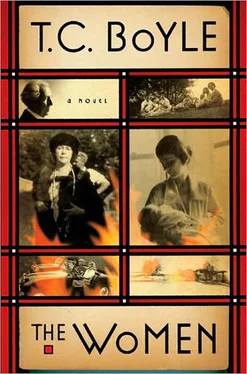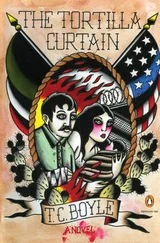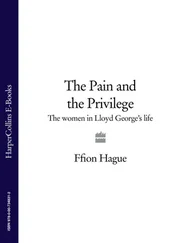7
One of those curious overheated phrases of O’Flaherty-San, which we will let stand.
8
Zona Gale, author of popular appeasements such as Miss Lulu Bett, who was then at the height of her fame, and more marginally, her beauty. But she kept cats and had claws of her own. And, of course, like all novelists, she had unrealistic expectations.
9
Officially, the Gurdjieff Institute for the Harmonious Development of Man, an oxymoronic designation, it seems to me.
10
Vlademar Hinzenberg. An architect. A Russian.
11
Wrieto-San was a great one for holidays — Memorial Day, the Fourth of July, Halloween, Thanksgiving, Christmas — and if there was no holiday in sight he would invent one to suit him, the Fundament of June, Midsummer’s Eve, the Pillars of March, the stronger the whiff of paganism the better. He was an inveterate arranger too, forever fussing over his furniture and objets d’art, and he threw himself into holiday decoration with all the fierceness of his unflagging energy (an energy, unfortunately, that often manifested itself in a sort of superhuman volubility that made it difficult to be around him for more than an hour or two at a time).
12
“The Elf King.” And what could be more appropriate?
13
Maude Miriam Noel, 1869–1930. Southern belle, sculptress, dilettante. Wrieto-San’s second wife. I never met her personally, but Billy Weston described her to me in some detail. “She was trouble,” he said. And then he used one of those peculiarly apposite American expressions — such a trove, the English language—“She was,” and he paused a moment to stare off into the distance, as if his brain, the actual organ, were being radically compressed by the squeezebox of the memory, “real hell on wheels.”
14
Of course, O’Flaherty-San is flexing his imagination here, trying to see things as Miriam would have seen them. I suspect the driver was what is known as a Chicano, a U.S. citizen of Mexican descent — or, perhaps, as my Spanish dictionary has it, a caudillo, a member of the Latin American ruling class whose blood remains relatively undiluted, making for fairer skin, but one wonders what such a man would be doing behind the wheel of a cab. On the other hand, he may have been Italian, after all.
15
Née Caruthers, 1870-?. A friend of Miriam’s youth in Memphis. They remembered each other’s birthdays and corresponded frequently, but never more voluminously or passionately than in the first few years of Miriam’s marriage — at fifteen — to Emil Noel, scion of a distinguished Southern family, who took her off to Chicago where he became a decidedly inartistic functionary at Marshall Field’s.
16
La Noire idole, Étude sur la Morphinomanie , by Laurent Tailhade. Paris: Leon Vanier, 1907. A defense and celebration of morphine, written to counter the sensationalism of Maurice Talmeyr’s Les Possédés de la morphine , which chose to view the use of this medicinal drug in what Tailhade considered an erroneous and negative light. In Miriam’s defense, it should be said that during her days in Paris — roughly 1904–1914—the use of morphine was widespread, particularly in fashionable and artistic circles, and was considered, on the whole, no more remarkable in a young woman than smoking, wearing trousers or imbibing cocaine-infused beverages like the wildly popular Vin Mariani.
17
Actual name. No need really to comment on these absurd juxtapositions of function and fate, but I did once consult a dentist in New Haven by the name of Dr. Hertz.
18
From 1914 to 1923. Wrieto-San took her up after the death of his previous mistress and first moved her into Taliesin in 1915, though he was still married to his first wife, Catherine, who refused to grant him a divorce. As indicated above, the people of the community — simple types, holding fast to their rustic mores and easily manipulated by tub-thumping editorial writers and backwoods preachers — were scandalized, treating Wrieto-San as a pariah. This animus may well have precipitated Wrieto-San’s decision to take on the commission for the Imperial Hotel and move — with his mistress — to Japan, a far more compliant and civilized country.
19
Metaphorically speaking, that is. At this stage of his life, in late middle age, Wrieto-San was growing stocky, devolving into the Welsh farmer he was born to be. By my reckoning, his shoulders were no wider than average.
20
To say the least. Typically his acolytes were allowed no more than four hours sleep a night and they spent the remaining twenty in the Master’s service, putting themselves through a routine of hard physical labor, dance movements and spiritual and psychological exercises designed to awaken them from the death-in-life of the closed consciousness. Some would call it slave labor, but in the end it wasn’t much different from what Wrieto-San would expect from his apprentices, though we did sleep, on average, an hour or two longer. And we didn’t dance. Not if we didn’t want to.
21
The Packard? I know Wrieto-San had one of these automobiles in 1929, a touring car he took with him to Arizona, but I’m not certain of the provenance of this one. Perhaps it was the Cadillac in which he fled to Minnesota in 1926 to escape prosecution on Mann Act charges. In any case, Wrieto-San changed cars the way most men change socks.
22
Amanatto, made from adzuki (red beans). My personal favorite are chitose, sweet-bean dumplings covered with pink and white sugar representing the glow of sunrise and snow on Mount Fuji. Each year for Setsubun my mother would make tray after tray of them, even when we were living in Washington, and allow my brothers and me to gorge on as many as we could hold. Which was fewer than you might think — bean paste is surprisingly filling, especially when it’s been sweetened to perfection.
23
La Miniatura, constructed in a ravine in Pasadena, was especially problematic. As were the flat roofs of all four of these unique, Mayan-inflected concrete-block houses, architectural treasures all. Leakage was to be expected — it was the fault of the climate, Wrieto-San would insist, nine months of desiccating sun, three months of monsoon rains — but he did personally see to the flashing for Mrs. Alice Millard, chatelaine of La Miniatura.
24
While he may have been the world’s greatest architect, Wrieto-San lacked expertise when it came to electrical devices. Half the wiring at Taliesin was jury-rigged and we were forever watching a lightbulb sizzle in the socket or plugging in a lamp or radio to the sound of an explosive pop and the odor of scorched wires.
25
No surname available. No one seemed to recall anything about him, except that he was called Mel.
26
One wonders if Wrieto-San ever stopped to think what he was doing. To create the fiction of Olgivanna as his housekeeper and almost immediately impregnate her begs the question.
27
By apprentices.
28
Martha (Mamah) Borthwick Cheney, 1869–1914.
29
A considerably inflated figure, it seems to me. But then Wrieto-San was always over-valuing his collections — his Japanese woodblock prints ( ukiyo-e ) especially — in order to raise money against them as a sop to the vast armies of his creditors.
30
Three mistresses, three Taliesins. One can only imagine how Olgivanna must have felt with regard to the line of succession. Given her private education, certainly she must have been acquainted with Henry VIII.
31
I don’t know how far this homily would go in assuaging the fears of a young girl morbidly afraid of lightning, but I had it from a reliable source — Svetlana herself. And she was a perfectly well-adjusted (and quite fetching) girl in her teens when I knew her at Taliesin. Of course, she did run off at seventeen to elope with Wes Peters, incensing Wrieto-San.
Читать дальше












